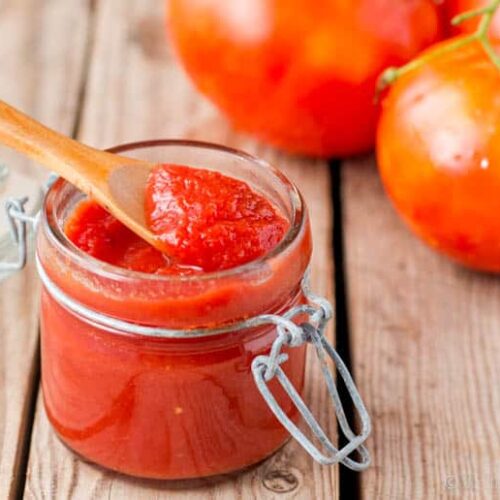Tomato extract (‘Strattu)

Portions: Makes 450 g/1 lb
Ingredients:
- 4.5 kg/10 lb very ripe, healthy tomatoes
- Salt
- 5-6 sprigs fresh sweet basil
- 2-4 tablespoons olive oil
- Coarse salt
Preparation:
Wash the tomatoes, remove their stems or stem ends, and cut them into small chunks. Pass the chunks of tomatoes through a food mill to remove skins and seeds. Salt the resulting purée to taste, making it just a little saltier than you would make a normal tomato sauce. Wash and dry the basil sprigs and add them to the purée. Spread the purée on a wooden tabletop in the sun. Don a large straw hat, equip yourself with a good book in one hand and a sturdy spatula in the other, and start stirring. The purée must be spread out, gathered in, stirred, and spread out again fairly continuously for two days, so that the sun can evaporate the water content. If at first the purée is so liquid that it won’t stay on the table, you may have to start the drying process in platters, and then transfer it onto the tabletop when the purée has become a little denser. Put the table on a porch for the night or in some other place where it will have air but no dew can collect on it. If your sun is not very hot, the drying process may take more than two days. When the extract has become so thick that it can be modelled like clay, remove the basil. Then oil your hands well and pack the extract little by little into a sterilised glass jar, pressing it down well so that no air bubbles remain. Cover the surface with a thin coat of oil, and sprinkle with 1-2 tablespoons of coarse salt. Cover the jar with a piece of muslin and store in a cool place. Each time you take some extract out, make sure that the remaining surface is covered with oil. Those who lack the temperament or the climate for making their own extract can use in its place commercial tomato paste, either the kind imported from Italy in a tube and known as double concentrate, or the tinned type. The final results, however, will not be quite the same. Another version of pasta and anchovies has no tomato in it, thus making it the older and, in the eyes of some, the more orthodox. It is also delightfully quick and easy, although if you use salted anchovies, as tradition requires, you have the messy task of filleting them. To do this, slide your thumb down the backbone and open the anchovy like a book. Remove the backbone, then wash thoroughly under running water to remove the excess salt and any residual scales. In any case salted anchovies are not easily found today, except in street markets, and anchovy fillets in olive oil make an excellent substitute. This recipe too requires toasted breadcrumbs, which Sicilians are very fond of sprinkling on their pasta in place of grated cheese. One cook of my acquaintance has told me that for fish and vegetable sauces she browns a couple of garlic cloves in the oil in which she toasts her breadcrumbs. To crumbs destined to be eaten with pasta in a pork and tomato sauce she adds a fresh sage leaf.
Visited 13 times, 1 visit(s) today
POTREBBE INTERESSARTI

